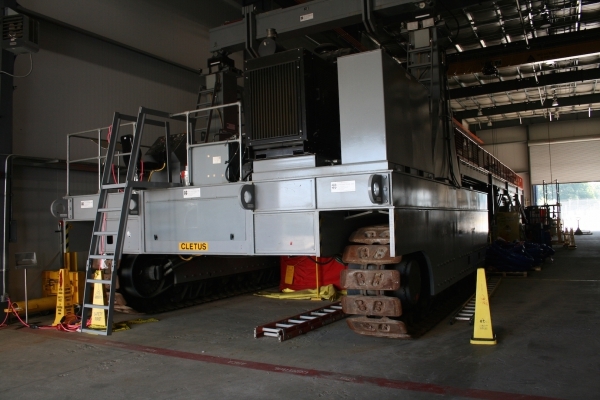VERNON — Vermont Yankee's radioactive spent fuel soon will be on the move.
In April, a contractor will begin loading the shut-down Vernon nuclear plant's fuel into sealed casks, which will be placed on a concrete pad.
The fuel is not going far: The pad is a short walk from the plant's reactor building, where thousands of spent fuel assemblies currently are stored.
But the move is important for two reasons: It's central to a proposed sale of Vermont Yankee, and it also will be a closely watched, tightly controlled transfer of hazardous material.
“We have a very precise set of procedures we follow for all of this,” said Joe Lynch, senior governmental affairs manager for Entergy Wholesale Commodities.
Vermont Yankee hasn't produced power for more than two years. But the majority of its spent fuel - nearly 3,000 assemblies - remains in a cooling pool inside the reactor building.
Because the federal government hasn't yet made good on a statutory promise to create a centralized, national depository for spent nuclear fuel, that material has to stay at Vermont Yankee for now.
Long-term storage
The solution - both in Vernon and at other shut-down nuclear plants - is to place the fuel inside specially made canisters known as dry casks for long-term storage.
Vermont Yankee already has 13 casks that were loaded with spent fuel in 2008 and 2011. But the plant will need 45 more such casks, and Entergy last year won state approval to build a second pad to hold all of the canisters.
At a Jan. 26 meeting of the Vermont Nuclear Decommissioning Citizens Advisory Panel, Lynch disclosed that the plant's next fuel-loading campaign will kick off in April. He also told panel members that a dozen new casks have been delivered to Vermont Yankee, with another eight expected in March and more due sometime later this year.
All told, Entergy expects that 27 casks will be loaded with spent fuel in 2017.
All aspects of the job - from manufacturing the casks to loading them in Vernon - are being handled by Florida-based Holtec International under the terms of a “turn-key contract” with Entergy, Lynch said.
It's a massive job that got under way last year and is expected to cost $143 million. Entergy is paying for the project via a line of credit, and administrators expect to seek reimbursement via legal action against the U.S. Department of Energy - a common tactic in the nuclear industry.
Entergy has twice modified the Vermont Yankee fuel-move schedule. The company initially pushed up the start date from 2019 to 2017, then moved the expected completion date from 2020 to 2018 to fit with the proposed sale of the plant to decommissioning contractor NorthStar Group Services Inc.
Entergy and NorthStar executives are hoping to close that sale by the end of 2018, but the fuel move has to be complete for that to happen. Hence Entergy's current plan to have all of Vermont Yankee's spent fuel in casks by the third quarter of 2018.
In a document submitted to the decommissioning advisory panel, Entergy said the tightened time frame for moving Vermont Yankee's spent fuel won't affect the job's bottom line.
“Certain costs would be incurred earlier than originally planned, but the overall cost of the project is not impacted,” administrators wrote.
However, the accelerated schedule is dependent on approvals from the federal Nuclear Regulatory Commission. That's because some of Vermont Yankee's fuel would be loaded into casks before reaching the standard five-year cooling period for such material.
New cask design
NRC officials have said the five-year period isn't a hard and fast rule, depending on type of fuel and cask design. And Jack Boyle, Vermont Yankee's decommissioning director, said Holtec has a “new and improved” cask designed - pending NRC approval - to accommodate a faster process.
“They're using a much-improved metal that has about 10 times the heat-transfer capability within the interior of the multipurpose canister,” Boyle said. “We can load 'hotter' fuel, if you will, that's been cooled for a shorter time period.”
If the NRC gives its blessing, Vermont Yankee apparently will be at the vanguard of such fuel-storage systems. “This is not just a Vermont Yankee thing,” Lynch said. “By getting this approval, Holtec will be able to utilize these canisters ... for any [nuclear plant] licensee who wants to take advantage of that.”
Though it may be happening more quickly at Vermont Yankee, the fuel move nevertheless remains a delicate job. And it has attracted scrutiny from critics who have noted the presence of the nearby Vernon Elementary School.
Brattleboro-based New England Coalition last year lobbied for underground fuel storage at Vermont Yankee, saying such a setup could be cheaper and safer. But the anti-nuclear group was rebuffed.
Vermont Yankee administrators have maintained that they're following a “methodical, careful process” in getting the radioactive fuel onto the storage pad. Casks are loaded inside the reactor building, then rolled slowly to the pad via a large, tracked transport vehicle nicknamed “Cletus.”
Lynch made reference to “heightened security” during that transfer, but he also said the fact that the fuel move is happening won't be readily apparent from outside the plant.
“It would be, essentially, not obvious to the public because it all happens in a very small area,” Lynch said.
